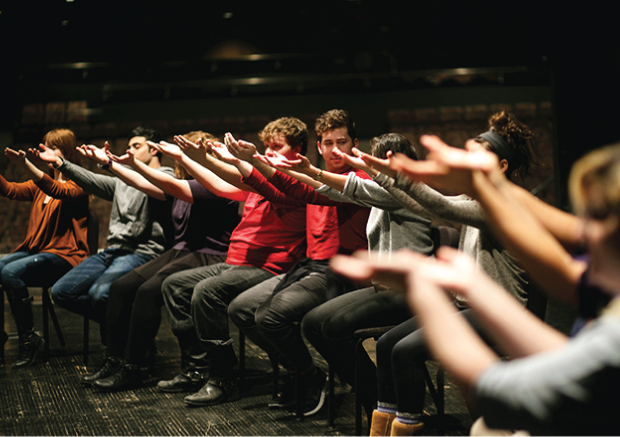On Friday, 600 HIGHWAYMEN — a theater group composed of Abigail Browde and Michael Silverstone — presented “The Fever.” Walking in, I knew that “The Fever” was not your ordinary theater performance — that is, I had read a bit about it beforehand. Personally, I’m a fan of interactive theater, but I haven’t engaged in that many professional productions. I stepped into Bing Studio not knowing what to think, but I stepped out feeling like I rediscovered my body and mind.
A large rectangle of chairs was arranged around the room. I noticed that there were lights behind the chairs, but I sat and fiddled with my phone a bit. I tried to pick out Browde and Silverstone, but couldn’t amongst all the other attendees. About 10 minutes after the scheduled start time, a flicker in the corner of my eye caught my attention. A number of attendees began to move their hands up and down, over and over again — I then was able to spot Browde as the one who initiated the movement. Around and around the rectangle it spread, washing over us like the wave it was.
It’s tough to explain how I felt as Browde and Silverstone stepped up and presented their stories, pulling attendees into the center and telling them to make a motion, then narrating the story themselves. It was eerie in a sort of calming way — we were puppets, but we were puppets in a grander gesture. As attendees and participants, we served the story — and thus the story was brought to life and blew into us a feeling of pure humanity.
The story itself then began to devolve as lights shifted and transformed the space. For the most part, I remained transfixed as group movements swirled into the hypnotizing stream of a hive mind. The first indication that something was different than what I expected was when one attendee made a movement that was different from what 600 HIGHWAYMEN instructed. I then began to get distracted by the fact that there were in fact more performers than just those two — and I was right. But the tricky thing was, I didn’t know how many.
The group actually ended up consisting of five performers, but I didn’t realize this until the end (I actually thought there were six). The most emotionally visceral moment in the show was when an older man began to instruct attendees to move him around, eventually instructing them to catch him as he fell, over and over again — but no one did. Again and again his limp body crashed to the ground, until finally, he lay still for about a minute. In that moment, I froze, not wanting to disrupt the performance. Eventually, someone stood up and helped him up.
“The Fever” shook me to the core because we had to work together, as strangers, but as a community, to participate in telling this story. We had to rely on each other and our instincts. So much of theater is observation and eternal empathy, but “The Fever” gets at something deeper. How do we react, how do we interact with one another when we don’t know what each other is thinking?
Something about “The Fever” made me start to rethink myself. Every moment in the performance when I was on display as a participant-performer, or was part of a group movement and task, I was forced to consider what I was doing. Everything was deliberate — or everything had to be, otherwise I was a bystander.
I encourage you to seek out more nontraditional theater. Something about it gets you out of your comfort zone and strives to make you think differently about yourself and the world around you. “The Fever” does an incredible job of reshaping your view of theater, art and life simply through words, actions and some simple changes in lighting and focus. Often, stripping art down to the bare minimum really does pay off.
Contact Olivia Popp at oliviapopp ‘at’ stanford.edu.
